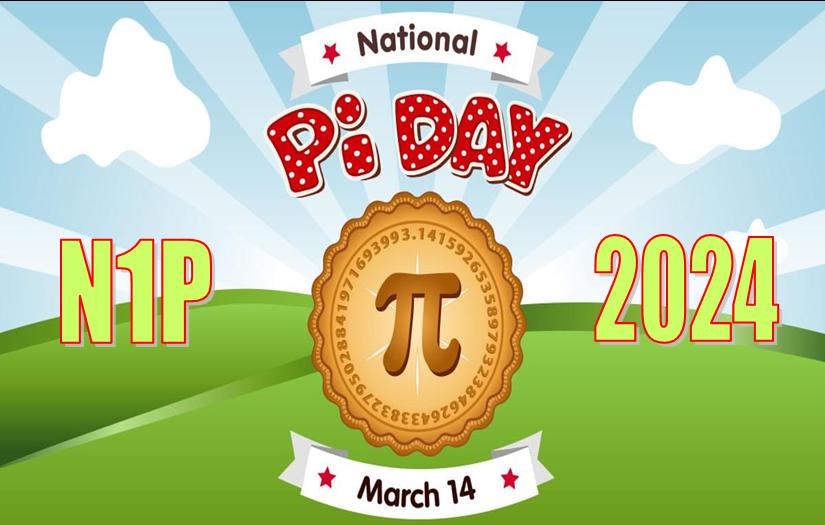


Welcome to the “ROC”
The ROC-HAM Radio Network in
Rochester, New York
where
Ham’s Really Rock
Easter Sunday Raspberry Pi Net – 31st March, 2024
Please note: There will be no Raspberry PI Net on March 31st due to it being EASTER SUNDAY.

K9EID – BoB Heil Silent Key, February 28,2024
Bob fought a year’s long battle with cancer, Bob’s life long passion for amateur radio and his dedications to audio engineering. Everything Bob did was for the betterment of amateur radio. Bob Heil will be sorely missed by all.
God bless you Dr. Bob Heil for all that you did for amateur radio and beyond.
How to Connect
ECHOLINK on the *ROC-HAM* Conference Server Node 531091
ALLSTAR Nodes 2585, 47620, 47918, 531310
DMR TGIF Talk Group 2585
DMR Extended Freedom Network Talk Group 2585
Extended Freedom Network SIP Portal 2585


Join us on the ROC-HAM RADIO NETWORK for a pop up net celebrating NATIONAL PI DAY
March 14,2024 at 4:00pm edt / 20:00 utc…where we will talk about fascinating PI facts and how they effect us today.
The ARRL special event committee has approved the special event callsign N1P for NATIONAL PI DAY…..!!!!
At 5.30 pm EDT the Net will Continue on 10 metres on 28.405 MHz
HF Bands-20m,40m,check back on day of event. 10m/28.405
We will commemorate this event by a special event QSL card upon request.
OPTION 1: Send a self addressed envelope to W2JLD(address is good on qrz)
OPTION 2: Send 5.00$ usd to my paypal account DMOTORSPORTS@GMAIL.COM and not worry about a S.A.S.E.
We will have the Extended Freedom connection as well they will be joining us!!!

Here are 31 fascinating facts about pi:
1. The symbol for Pi has been in use for over 250 years. The symbol was introduced by William Jones, a Welsh mathematician, in 1706. The symbol was made popular by the mathematician Leonhard Euler.
2. Since the exact value of pi can never be calculated, we can never find the accurate area or circumference of a circle.
3. March 14 or 3/14 is celebrated as pi day because 3.14 are the first digits of pi. Math nerds around the world love celebrating this infinitely long, never-ending number.
4. The record for reciting the most number of decimal places of Pi was achieved by Rajveer Meena at VIT University, Vellore, India on 21 March 2015. He was able to recite 70,000 decimal places. To maintain the sanctity of the record, Rajveer wore a blindfold throughout the duration of his recall, which took an astonishing 10 hours! Can’t believe it? Well, here is the evidence.
5. Pi is actually a part of Egyptian mythology. People in Egypt believed that the pyramids of Giza were built on the principles of pi. The vertical height of the pyramids have the same relationship with the perimeter of their base as the relationship between a circle’s radius and its circumference. The pyramids are phenomenal structures and are one of the seven wonders of the world.
6. Physicist Larry Shaw started celebrating 14 March as Pi day at San Francisco’s Exploratorium science museum. There he is known as the Prince of Pi.
7. There is an entire language made from the number Pi. But how is that possible? Well, some people loved pi enough to invent a dialect based on it. In “Pi-lish” the number of letters in each word match the corresponding digit of pi. This first word has three letters, the second has one letter, the third has four letters, and so on. This language is more popular than you might think. Software engineer Michael Keith wrote an entire book, called Not a Wake in this language.
8. Pi wasn’t always known as pi. Before the 1700s, people referred to the number we know as pi as “the quantity which when the diameter is multiplied by it, yields the circumference”. Not surprisingly, people got tired of saying so much whenever they wanted to talk about Pi. The Welsh mathematician William Jones, a friend of Sir Isaac Newton, began using the symbol for pi in 1706.
9. We will never be able to find all the digits of pi because of its very definition as an irrational number. Babylonian civilization used the fraction 3 ⅛, the Chinese used the integer 3. By 1665, Isaac Newton calculated pi to 16 decimal places. Computers hadn’t been invented yet, so this was a pretty big deal. In the early 1700s Thomas Lagney calculated 127 decimal places of pi, reaching a new record. In the second half of the twentieth century, the number of digits of pi increased from about 2000 to 500,000 on the CDC 6600, one of the first computers ever made. This record was broken again in 2017 when a Swiss scientist computed more than 22 trillion digits of pi. The calculation took over a hundred days.
10. The usefulness of pi has been a matter of debate, although it is loved by a lot of math enthusiasts. Some believe that tau (which amounts to 2π) is a better suited to circle calculations. For instance, you can multiply tau with the radius of a to calculate its circumference more intuitively. Tau/4 also represents the angle of a quarter of a circle.
11. In the Exploratorium science museum, a circular parade happens every year on pi day. Each person participating holds one digit in the number pi. It wasn’t celebrated around the United States like it is now until Congress passed Resolution 224, which designated March 14th as pi day. Congress hoped that celebrating pi day would cultivate a higher level of enthusiasm for math and science among American students.
12. The calculation of pi is a stress test for a computer. It works just like a digital cardiogram since it indicates the level of activity within the computer’s processor.
13. Givenchy sells a men’s cologne with the name ‘Pi’. The company markets this product as capable of enhancing the attractiveness of intelligent and visionary men.
14. The number pi is not just an important part of conversations among mathematicians or students. In the famous O.J. Simpson trial, the defense attorney and FBI agent’s argument revolved around the value of pi. The FBI agent’s findings in the case weren’t accurate because he used pi inaccurately.
15. The number pi was so alluring, even in the 16th century, that Dutch-German mathematician Ludolph van Ceulen spent most of his life calculating the first 36 digits of pi. It is said that the first 36 numbers were engraved on his tombstone, which is now lost.
16. William Shanks, a British mathematician, worked manually to find the digits of pi in 1873. He spent many years trying to calculate the pi digits by hand and found the first 707 digits. Unfortunately, the 527th digit he found was wrong, which made all the following digits wrong as well.
17. In the year 1888, an Indiana country doctor claimed that he had learned the exact measure of a circle through supernatural means. He believed in his “supernatural” knowledge so much that he filed a proposal to pass a bill in the Indiana legislature so that he could copyright his genius findings. However, there was a math professor in the legislature who showed the fellow how his proposed bill would result in a wrong value of pi.
18. The number pi is literally infinitely long. But the number 123456 doesn’t appear anywhere in the first million digits of pi. It is a bit shocking because if a million digits of pi don’t have the sequence 124356, it definitely is the most unique number.
19. Chinese people were far ahead of the West in finding the digits of pi. Why? Chinese mathematicians were ahead in the pi game because of two reasons: they had decimal notations and they had a symbol for the number zero. It wasn’t until the late middle ages that European mathematicians started using the number zero. At that time, European mathematicians partnered with Arab and Indian minds to bring the symbol of zero into their system.
20. In ancient times, mathematicians used a unique method to calculate pi. They would add more and more sides to a polygon so that its area approached the area of a circle. Archimedes, the most famous Greek mathematician and inventor, used a polygon with 96 sides. Many other mathematicians also used this polygon-method to compute the infinitely long number pi. In China, a mathematician used over 3,000 sides in a polygon to arrive at the value 3.14159. Another mathematician used about 25,000 sides to calculate pi.
21. Many mathematicians believe that it is more accurate to say that a circle has infinite corners than it is to say that it has none. It is only reasonable to assume that the infinite number of corners in a circle correlates to the infinite number of digits of pi.
22. The number pi is very effective when you used in calculations For instance, rounding the number pi to just 9 digits after the decimal and use it to calculate earth’s circumference yield incredibly accurate results. For every 25,000 miles, the number pi will only err to 1/4th of an inch.
23. Even today, people are racing to calculate more digits of pi in a never ending competition. In the year 2010, a Japanese engineer and an American computer wizard broke the record for the most number of pi digits by calculating up to 5 trillion digits of pi. The amazing part is that they didn’t use any supercomputers. They just used desktop computers, 20 external hard disks, and their brilliant minds.
24. The Greek letter π is the first letter of the word periphery and perimeter. And as we all know, pi is the ratio of a circle’s “periphery” to its diameter.
25. Interestingly, some of the most famous scientists in the world have a connection to pi day. Albert Einstein was born on March 14th, 1879. Stephen Hawking died on March 15th, 2018 at the age of 76.
26. Pi Day is a relatively new holiday, In 1988, Larry Shaw of San Francisco’s Exploratorium science museum started observing March 14 as Pi Day. March 14—get it? It’s 3/14 … and it also happens to be Albert Einstein’s birthday. By 2009, the celebration had grown so big that Congress passed a resolution to make the designation official. The resolution states: “The House of Representatives supports the designation of a ‘Pi Day’ and its celebration around the world … and encourages schools and educators to observe the day with appropriate activities that teach students about pi and engage them about the study of mathematics.” In another stamp of approval, in 2010, Pi Day got its own Google Doodle.
27. State lawmakers once tried to round up pi to 3.2 – If we don’t need all those decimal places in pi, wouldn’t it be easier to just call it 3.2? One of the more bizarre facts about pi is that in 1897, an Indiana doctor decided that the world should go ahead and use 3.2 for any calculations requiring pi. Dr. Edwin Goodwin proposed a bill in the state legislature. He even copyrighted this idea and planned to charge royalty fees for anyone who used it—except for those in the state of Indiana. After some debate, the state senate realized that the idea of using a law to change a mathematical constant was a silly one, and the law failed to pass.
28. Someone has memorized 100,000 digits of pi, According to The Guardian, Akira Haraguchi recited 100,000 digits of pi back in 2006. This impressive task reportedly took him a cool 16 hours and 30 minutes to complete. We have one word: Wow!
29. Pi is a record setter in more ways than one, Guinness World Records has recognized a variety of pi-themed accomplishments. In 2014, 589 people at an elementary school in Germany formed the largest human pi symbol. And in 2017, 520 teachers and students in Todi, Italy, formed the longest human representation of pi digits. The city’s mayor held up a sign bearing the number three, and then each person after him stood in for a digit of pi after the decimal place.
30. You can do a magic trick to calculate pi, To try this easy activity known as Buffon’s Needles, you’ll need a large sheet of paper, at least 30 toothpicks, a ruler and a pen. Using a toothpick to determine the distance between them, draw a series of parallel lines on your paper. Then throw the toothpicks onto the paper at random.
Next, take away any toothpicks that are only partially on the paper, or that didn’t land on the paper at all. Count how many are left on the paper. Also count how many cross a line.
Divide the total number of toothpicks by the line-crossing toothpicks. Now multiply by two, and you should get pi!
31. A pi-themed crop circle left scientists scratching their heads, In 2008, a 150-diameter crop circle suddenly appeared by Barbury Castle, near the English village of Wroughton. Researchers and conspiracy theorists puzzled over its origin and meaning, and an astrophysicist eventually figured out that the image was a code representing the first 10 digits of pi.

K3JRZ – Jeff modeling the coveted Raspberry Pi t-shirt



We are currently looking for volunteers to join our Net Control team for the Raspberry Pi Net. If you are a seasoned Net Control Operator or would like to give Net Control a try for the first time please get in touch. We do utilise the Netlogger Software for the Raspberry Pi Net so if you are familiar with Netlogger that would be great. If not it is not that difficult to use and full training can be given.
The Raspberry Pi Net runs for about two hours every Sunday starting at 1700 hrs Eastern Time, that is 2100 Hrs UTC.
You do not have to be based in the United States. Everybody is welcome.
If you are interested please contact John W2JLD at w2jld2@gmail.com or Dave GW8SZL at gw8szl@yahoo.co.uk


For the Raspberry Pi Net Trivia Q & A please click HERE
Welcome to the ROC-HAM Radio Network Website
This site was set up to inform, educate and most of all, a place to go to share information with what is going on with the ROC-HAM EchoLink conference. The ROC-HAM Conference just celebrated 3rd year of its inception.
The ROC-HAM Conference was born out of an ideal for a place for hams to go and share info, keep up to date with special events that goes on throughout the year on the conference.
Since I’ve been licensed I’ve always wanted an EchoLink Conference, well after 5 years and many hours of hard work it paid off.
Now there is a permanent home for the “WORLD AMATEUR RADIO DAY and HEDY LAMARR” Special events that have been going on for the last 9 years and respectively as well as the last 8 years.
The ROC-HAM Radio Network has more special events than any other system that we are aware of, as a matter of fact we will be doing a regular new special event shortly after WORLD AMATEUR RADIO DAY and that is INTERNATIONAL MARCONI DAY – April 27th. Plus we have added another special event celebrating the Special event for NEW YORK total solar eclipse on April 8th.
Save these dates for special events in APRIL :
APRIL 8TH 2024 – SOLAR ECLIPSE 2024 – Special event for NEW YORK total eclipse
APRIL 18TH 2024 – 9TH ANNUAL WORLD AMATEUR RADIO DAY
APRIL 27TH 2024 – INTERNATIONAL MARCONI DAY
Details will follow as we get closer to that date.
We have more giveaways than any other system, we have never ever asked for donations and we will continue to do what we do without a need to ask for donations as others have done.
This site is to foster the ham radio arts, bring people together, share experiences, and learn new technologies along the way. Meet some amazing people from all over the world, and most importantly, HAVE FUN ALONG THE WAY.
This website and it contents would not be possible if not for the hard work and dedication and grateful for all the guidance that I have received from my right hand man, Dave Phillips/GW8SZL. Dave has been a great teacher and his patience and dedication are without saying.
The ROC-HAM Conference is node number 531091 on the ECHOLINK system and on ALLSTAR system nodes 2585, 47620, 47918, 531310. Also on DMR TGIF Talk Group 2585.
The ROC-HAM Conference also has a dedicated YOUTUBE channel named “WORLD AMATEUR RADIO DAY”.
That channel will have live streaming audio from special events that the “ROC” will be hosting and sometimes you just might hear a live feed of a net that is on the “ROC”.
There are great videos to watch.
The “ROC” has nets from 7:30am thru late in the evening, Monday – Sunday. Whatever time of day it is, you are sure to find stations from all over the world connected sharing their stories and comments.
The “ROC” is located in Rochester, NY. I’m on the southern tip of Lake Ontario, home of a famous film maker and of course home to Susan B. Anthony, famous for her own achievements.
There is a lot of great info on this site, and along the way it will grow with content that most hams will find useful.
Thank you for coming to the site, hope you enjoy it. If you have any comments or suggestions please feel free to leave us a note.
From all of us at the “ROC”.


